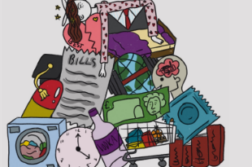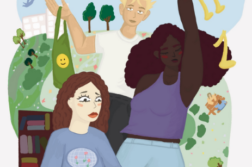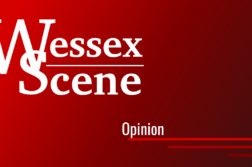Last month, British Vogue announced that its July 2020 cover stars would be three (extra)ordinary women in the shape of keyworkers: a midwife, a London train driver, and a supermarket employee. This has proved that anyone, of any profession, age or ethnicity, deserves to be celebrated alongside the likes of Rihanna and Gigi Hadid on the cover of the world’s biggest fashion magazine.
Enter the #VogueChallenge – the latest trend sweeping Instagram and TikTok. The challenge sees ordinary people editing their photos to include the iconic Vogue logo, making them into their very own cover-star. More recently, the challenge has aligned with the Black Lives Matter movement, with black creatives especially using the high-fashion template to showcase their work.
Oslo-based model Salma Noor kicked off the trend, posting a beautiful black and white shot of her in her hijab along with the Vogue logo and a headline proclaiming that “being Black is not a crime”. Since then, thousands of other black creatives have been inspired to celebrate themselves and their work in a similar way.
The politicisation of this challenge has come at a crucial moment for the future of high-fashion media. Only 20 of the 214 covers produced by the 19 bestselling women’s magazines in the UK featured people of colour in 2017, and Vogue has only had 21 black women appear solo on its covers in 127 years. These figures are indicative of the severe under-representation of non-white people in the industry.
Similarly, the staff behind the scenes of fashion magazines are overwhelmingly white, with Tyler Mitchell becoming the first black photographer to ever shoot a cover story for Vogue when he shot Beyoncé for the September 2018 issue. This challenge has thus allowed for a celebration and amplification of black creativity and voices.
British Vogue, led by its first black editor-in-chief Edward Enninful since 2017, has expressed support for the challenge, with Janelle Okwodu, a fashion writer at Vogue, hailing the fact that it “specifically highlights creators who were historically excluded from the conversation”.
Enninful kicked off his leadership with a cover featuring British-Ghanaian model Adwoa Aboah in December 2017. He later became the first editor to include a model wearing a hijab on the cover of Vogue when Kenyan model Halima Aden took centre-stage on the front of May 2018 edition. His appointment alone was a big step in validating black talent and influence in the industry.
However, the whole culture of women’s glossy mags is still often criticised as being largely white and middle-class. In the midst of the challenge’s success, Vogue’s editor-in-chief Anna Wintour made a statement apologising for the lack of inclusivity in the magazine under her leadership, saying that…
“I want to say plainly that I know Vogue has not found enough ways to elevate and give space to black editors, writers, photographers, designers and other creators. […] I take full responsibility for those mistakes”.
We can only hope that the industry at large will eventually realise that extensive change needs to be made within its structures for it to be described as truly inclusive.
Okwodu summarises the trend by saying that
“there is a pro-activeness to the challenge: rather than wait for fashion to take notice, the entrants took matters into their own hands”.
It is with this urgency and determination that the fashion industry needs to be reinvigorated for a new generation of multicultural and diverse creators who refuse to be overlooked.



